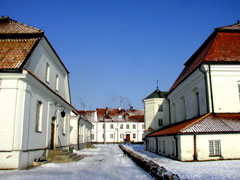Tykocin

Tykocin (in Jewish sources, Tiktin; Rus. Tykotsin), village in Bialystok province, N.E. Poland. Tykocin was formerly a town on the border between the kingdom of Poland and the principality of Lithuania. In 1522 the noble family of Gashtold, who owned Tykocin, invited ten Jewish families from *Grodno to settle there. They were given sites for homes and were later allowed to establish shops, a synagogue, a cemetery, and an autonomous community. A charter (1536) provided that the rabbi and the head of the town council should jointly judge cases between a Jew and a gentile. By 1576 there were 54 houses owned by Jews, who engaged in wholesale trading of salt, spices, and cloth. Their rights were confirmed by special royal privileges in 1576 and 1639. In 1642 a baroque synagogue was erected, which until 1740 was the finest building in the town (it still stood in 1970, preserved as a historical site, although the Nazis ruined the interior and the women's section).
With the growth of the community Tykocin achieved independence from the kahal of Grodno. Between 1621 and 1654 Tykocin conducted a successful struggle with Grodno involving the hegemony over the communities of Choroszcz, *Zabludow, *Gorodok, and Wasilkow. In 1623 Tykocin severed its ties with the Council of Lithuania and instead declared allegiance to the *Council of Four Lands. It became one of the most important communities in the region in the 17th and 18th centuries. The communities of Podlasie (*Siemiatycze, Wysokie Mazowieckie, *Miedzyrzec Podlaski, Bransk) and eastern Masovia (*Ciechanow) were under the jurisdiction of the Tykocin kahal, which was the chief community in the galil (province) of Tykocin. In 1660 the Jews of Tykocin suffered at the hands of the Swedish army and the troops of the Polish general, S. Czarniecki. In the 18th century the Tykocin community weakened and its influence in the area diminished.
Tykocin's rabbis until the end of the 18th century included some important halakhic authorities: Mordecai (1568); Menahem David b. Isaac, a student of Moses *Isserles; Samuel Eliezer *Edels (in the 1620s); Joshua b. Joseph, author of the talmudic commentary Penei Yehoshu'a (early 1630s); Isaac Aizik b. Eliezer Lipman Heilperin (1667–81); Elijah *Shapira, head of the rabbinical court of Prague, who became nonresident rabbi of Tykocin in 1703; and Shalom ben Eliezer Rokeaḥ (1756–66). In 1765 there were 2,694 Jews in Tykocin and nearby villages who paid the poll tax, and in 1808 there were 1,652 (56% of the total population). In 1815 the town was annexed to Congress Poland and the Russian administration allowed free Jewish settlement of the area. There were 2,701 Jews (64%) in 1827; 3,456 (70%) in 1857; and 2,484 (59%) in 1897. The Jews earned their livelihoods in small trade and crafts. Between 1919 and 1920 the community suffered at the hands of Russian and Polish armies which passed through the town. Between the two world wars the Jews manufactured brushes and prayer shawls (Talitot Tiktin). In 1921 there were 1,401 Jews (49%) in Tykocin. Various Zionist parties, mainly *He-Halutz, were active and there was a *Tarbut school.
BIBLIOGRAPHY:
Halpern, Pinkas, index; idem, Yehudim ve-Yahadut be Mizraḥ-Eiropah (1959), 139–51; E. Schreiber, Abraham Geiger (Eng., 1892), 20, passim; S. Dubnow (ed.), Pinkas ha-Medinah (1925); idem, in: Sefer ha-Yovel li-Khevod Naḥum Sokolow (1904); M. Tolczyn (ed.), Pinkes Tiktin (1949); M. Bar-Juda and Z. Ben-Nahum (eds.), Sefer Tiktin (1959); H.H. Ben-Sasson, Hagut ve-Hanhagah (1959), index; M. Baliński and T. Lipiński, Starożytna Polska, 2 (1845), 533; B. Wasiutyński, Ludność żydowska w Polsce w wiekach XIX i XX (1930), 36; S. Zajczyk, in: Zakład architektury polskiej… Politechniki warszawskiej, Biuletyn naukowy, 1:4 (1933); I. Schiper, Dzieje handlu żydowskiego na ziemiach polskich (1937), index; A. Kubiak, in: BŻIH, 8 (1953), 81–84; Przyboś (ed.), Polska w okresie drugiej wojny północnej, 1655 – 1660, 2 (1957), index.
Sources: Encyclopaedia Judaica. © 2008 The Gale Group. All Rights Reserved.


